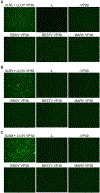A Chimeric Lloviu Virus Minigenome System Reveals that the Bat-Derived Filovirus Replicates More Similarly to Ebolaviruses than Marburgviruses
- PMID: 30184492
- PMCID: PMC6159894
- DOI: 10.1016/j.celrep.2018.08.008
A Chimeric Lloviu Virus Minigenome System Reveals that the Bat-Derived Filovirus Replicates More Similarly to Ebolaviruses than Marburgviruses
Abstract
Recently, traces of zoonotic viruses have been discovered in bats and other species around the world, but despite repeated attempts, full viral genomes have not been rescued. The absence of critical genetic sequences from these viruses and the difficulties to isolate infectious virus from specimens prevent research on their pathogenic potential for humans. One example of these zoonotic pathogens is Lloviu virus (LLOV), a filovirus that is closely related to Ebola virus. Here, we established LLOV minigenome systems based on sequence complementation from other filoviruses. Our results show that the LLOV replication and transcription mechanisms are, in general, more similar to ebolaviruses than to marburgviruses. We also show that a single nucleotide at the 3' genome end determines species specificity of the LLOV polymerase. The data obtained here will be instrumental for the rescue of infectious LLOV clones for pathogenesis studies.
Keywords: Ebola virus; Lloviu virus; Marburg virus; RNA-dependent RNA polymerase; emerging viruses; filoviruses; minigenomes; replication and transcription.
Copyright © 2018 The Author(s). Published by Elsevier Inc. All rights reserved.
Conflict of interest statement
DECLARATION OF INTERESTS
The authors declare no competing interests.
Figures




Similar articles
-
Recombinant Lloviu virus as a tool to study viral replication and host responses.PLoS Pathog. 2022 Feb 4;18(2):e1010268. doi: 10.1371/journal.ppat.1010268. eCollection 2022 Feb. PLoS Pathog. 2022. PMID: 35120176 Free PMC article.
-
Development of a Měnglà virus minigenome and comparison of its polymerase complexes with those of other filoviruses.Virol Sin. 2024 Jun;39(3):459-468. doi: 10.1016/j.virs.2024.03.011. Epub 2024 May 21. Virol Sin. 2024. PMID: 38782261 Free PMC article.
-
Assessment of the function and intergenus-compatibility of Ebola and Lloviu virus proteins.J Gen Virol. 2019 May;100(5):760-772. doi: 10.1099/jgv.0.001261. Epub 2019 Apr 24. J Gen Virol. 2019. PMID: 31017565
-
Distinct Genome Replication and Transcription Strategies within the Growing Filovirus Family.J Mol Biol. 2019 Oct 4;431(21):4290-4320. doi: 10.1016/j.jmb.2019.06.029. Epub 2019 Jun 29. J Mol Biol. 2019. PMID: 31260690 Free PMC article. Review.
-
Current perspectives on the phylogeny of Filoviridae.Infect Genet Evol. 2011 Oct;11(7):1514-9. doi: 10.1016/j.meegid.2011.06.017. Epub 2011 Jun 30. Infect Genet Evol. 2011. PMID: 21742058 Free PMC article. Review.
Cited by
-
Recombinant Lloviu virus as a tool to study viral replication and host responses.PLoS Pathog. 2022 Feb 4;18(2):e1010268. doi: 10.1371/journal.ppat.1010268. eCollection 2022 Feb. PLoS Pathog. 2022. PMID: 35120176 Free PMC article.
-
Ebolavirus polymerase uses an unconventional genome replication mechanism.Proc Natl Acad Sci U S A. 2019 Apr 23;116(17):8535-8543. doi: 10.1073/pnas.1815745116. Epub 2019 Apr 8. Proc Natl Acad Sci U S A. 2019. PMID: 30962389 Free PMC article.
-
Development of a Měnglà virus minigenome and comparison of its polymerase complexes with those of other filoviruses.Virol Sin. 2024 Jun;39(3):459-468. doi: 10.1016/j.virs.2024.03.011. Epub 2024 May 21. Virol Sin. 2024. PMID: 38782261 Free PMC article.
-
Non-Ebola Filoviruses: Potential Threats to Global Health Security.Viruses. 2024 Jul 23;16(8):1179. doi: 10.3390/v16081179. Viruses. 2024. PMID: 39205153 Free PMC article. Review.
-
Low-Input, High-Resolution 5' Terminal Filovirus RNA Sequencing with ViBE-Seq.Viruses. 2024 Jul 1;16(7):1064. doi: 10.3390/v16071064. Viruses. 2024. PMID: 39066227 Free PMC article.
References
-
- Baize S, Pannetier D, Oestereich L, Rieger T, Koivogui L, Magassouba N, Soropogui B, Sow MS, Keïta S, De Clerck H, et al. (2014). Emergence of Zaire Ebola virus disease in Guinea. N. Engl. J. Med 371, 1418–1425. - PubMed
-
- Bausch DG (2017). West Africa 2013 Ebola: from virus outbreak to humanitarian crisis. Curr. Top. Microbiol. Immunol 411, 63–92. - PubMed
-
- Boehmann Y, Enterlein S, Randolf A, and Mühlberger E (2005). A reconstituted replication and transcription system for Ebola virus Reston and comparison with Ebola virus Zaire. Virology 332, 406–417. - PubMed
Publication types
MeSH terms
Substances
Grants and funding
LinkOut - more resources
Full Text Sources
Other Literature Sources
Medical
Research Materials

